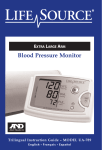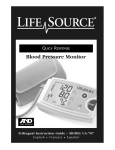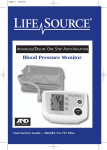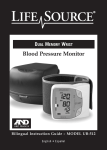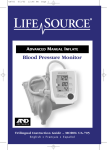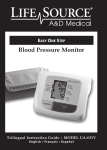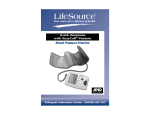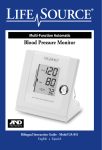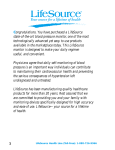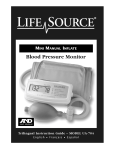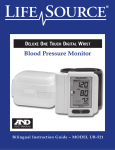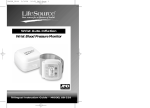Download A&D UA-631V Specifications
Transcript
Easy One Step Blood Pressure Monitor Trilingual Instruction Guide – MODEL UA-631V -631V Manual_English.indd 1 E n g li sh • Franç ais • E s paño l 8/5/09 8:08:36 PM This Monitor is clinically validated This LifeSource blood pressure monitor has undergone and passed a Clinical Validation study to determine the performance and accuracy. This monitor is clinically validated according to the British Hypertension Society (BHS) standard. The BHS is the most prestigious international blood pressure organization. The published study was performed by a reviewing committee consisting of physicians and/or nurses. -631V Manual_English.indd 2 8/5/09 8:08:36 PM important information Please read this important information before using your monitor. ☞ ☞ ☞ ☞ ☞ ☞ ☞ Please remember that only a medical practitioner is qualified to interpret your blood pressure measurements. Use of this device should not replace regular medical examinations. Have your physician review your procedure for using this device. He or she will want to verify blood pressure measurements before prescribing or adjusting medications. Consult your physician if you have any doubt about your readings. Should a mechanical problem occur, contact A&D Medical. Do not attempt to service, calibrate, or repair this monitor. Because your UA-631V monitor contains delicate, highprecision parts, avoid exposing it to extremes in temperature or humidity or to direct sunlight, shock and dust. A&D Medical guarantees the accuracy of this monitor only when it is stored and used within the temperature and humidity ranges noted on page E-17. Clean the monitor and cuff with a dry, soft cloth or a cloth dampened with water and a mild detergent. Never use alcohol, benzene, thinner or other harsh chemicals to clean monitor or cuff. Remove and replace batteries if monitor is not used for more than six months. Alkaline batteries recommended. PRECAUTIONS The UA-631V is designed to be used at home, by those who are eighteen (18) years and older, to monitor blood pressure (systolic and diastolic) and pulse rate. It is not designed for ambulatory use. -631V Manual_English.indd 3 8/5/09 8:08:36 PM -631V Manual_English.indd 4 8/5/09 8:08:37 PM TABLE OF CONTENTS ? WHAT DISPLAY SYMBOLS MEAN . . . . . . . . . . . . . . . . . . . . . . . . E-2 MONITOR COMPONENTS . . . . . . . . . . . . . . . . . . . . . . . . . . . . . . . E-3 HOW UA-631V WORKS . . . . . . . . . . . . . . . . . . . . . . . . . . . . . . . . . E-4 BEFORE YOU START . . . . . . . . . . . . . . . . . . . . . . . . . . . . . . . . . . . . E-4 SELECTING THE CORRECT CUFF Size . . . . . . . . . . . . . . . . . . . E-5 TAKING YOUR BLOOD PRESSURE . . . . . . . . . . . . . . . . E-6 — E-7 WHAT IS AN IRREGULAR HEARTBEAT . . . . . . . . . . . . . . . . . . . E-8 About cuff inflation METER . . . . . . . . . . . . . . . . . . . . . . . . E-8 ABOUT average reading . . . . . . . . . . . . . . . . . . . . . . . . . . . . . E-9 ABOUT PRESSURE RATING INDICATOR™ . . . . . . . . . . . . . . . . E-9 ABOUT MEMORY . . . . . . . . . . . . . . . . . . . . . . . . . . . . . . . . . . . . . . E-10 ABOUT BLOOD PRESSURE . . . . . . . . . . . . . . . . . . . . . E-11 — E-15 troubleshooting . . . . . . . . . . . . . . . . . . . . . . . . . . . . . . . . . . e-16 SPECIFICATIONS . . . . . . . . . . . . . . . . . . . . . . . . . . . . . . . . . . . . . E-17 CONTACT INFORMATION . . . . . . . . . . . . . . . . . . . . . . . . . . . . . E-18 FRENCH INSTRUCTIONS . . . . . . . . . . . . . . . . . . . . . . . . . . . . . . . . F-1 SPANISH INSTRUCTIONS . . . . . . . . . . . . . . . . . . . . . . . . . . . . . . S-1 -631V Manual_English.indd 1 8/5/09 8:08:37 PM WHAT DISPLAY SYMBOLS MEAN Display Symbol Condition/Cause Recommended Action The symbol shown while measurement is in progress. It blinks while detecting the pulse. Measurement is in progress, remain as still as possible. An irregular heartbeat or body movement may have occurred. Refer to page E-8 for more information on irregular heartbeats. Take measurement again and consult with your physician. Previous measurement stored in MEMORY. Battery Full Battery Low E-2 -631V Manual_English.indd 2 The battery power indicator during measurement. The batteries are low when it blinks. Replace all batteries with new ones when the symbol blinks. Alkaline batteries recommended. Unstable blood pressure due to excessive body movement. Try the measurement again. Remain very still during the measurement. The systolic and diastolic values are within 10 mmHg of each other. Fasten the cuff correctly, and try the measurement again. The pressure value did not increase during inflation. Check for air leaks along the tube and around the air socket. The cuff is not fastened correctly. Refasten the cuff and retake measurement. There is an air leak in the cuff or monitor. Make sure tube is properly connected to cuff and monitor. The pulse is not detected correctly. The symbol will appear on the pulse display area. Try the measurement again. Remain very still during the measurement. Cuff Inflation Meter Measurement is in progress, remain as still as possible Pressure Rating Indicator™ Refer to the section “About Pressure Rating Indicator” for further explanation. LifeSource Health Line (Toll-Free): 1-888-726-9966 8/5/09 8:08:39 PM MONITOR COMPONENTS SYSTOLIC PRESSURE DIASTOLIC PRESSURE PRESSURE RATING INDICATOR PULSE RATE CUFF INFLATION METER Irregular Heartbeat START BUTTON AIR CONNECTOR PLUG AIR SOCKET MEMORY BUTTON AIR HOSE ARM CUFF PROPER FIT RANGE BATTERY COVER INDEX MARK 1.5V BATTERIES (AA, R6P or LR6) batteries not included BATTERY COMPARTMENT In Canada - Auto Control Medical (Toll-Free): 1-800-461-0991 -631V Manual_English.indd 3 E-3 8/5/09 8:08:39 PM HOW UA-631V WORKS Lifesource blood pressure monitors are easy to use, accurate and digitally display full measurement readouts. Our technology is based on the “oscillometric method” – a noninvasive blood pressure determination. The term “oscillation” refers to any measure of vibrations caused by the arterial pulse. Our monitor examines the pulsatile pressure generated by the arterial wall as it expands and contracts against the cuff with each heartbeat. The cuff is inflated until the artery is fully blocked. The inflation speed is maximized and the pressure level is optimized by the device. The monitor takes measurements while the cuff is both inflating and deflating. This results in a faster measurement providing greater comfort to the user. before you start You must install 4 type AA (1.5 volt) batteries not included (alkaline batteries recommended) and attach the cuff to the monitor before using it. To install batteries (or replace them if the “Low Battery” symbol appears on display), proceed as follows: 1. Remove battery compartment cover by gently pushing down on arrow and sliding cover forward. 2. Put in bottom row of batteries first. Place the batteries in compartment with positive (+) and negative (–) terminals matching those indicated in the compartment. Be sure batteries make contact with compartment terminals. 3. Replace cover by sliding it into the compartment and gently pressing into place. NOTE: Rechargeable batteries will not work with this monitor. E-4 -631V Manual_English.indd 4 LifeSource Health Line (Toll-Free): 1-888-726-9966 8/5/09 8:08:40 PM SELECTING THE CORRECT CUFF SIZE Using the correct cuff size is important for an accurate reading. A cuff that is too large will produce a reading that is lower than the correct blood pressure; a cuff that is too small will produce a reading that is higher than the correct blood pressure. With your arm hanging at the side of your body, measure the circumference of your upper arm at the midpoint between the shoulder and elbow. Cuff Size Indicator On The Cuff Our cuff has an indicator which tells you whether you are using the correct cuff size or not. Place the cuff on your arm (see Page E-6 to learn how to put the cuff on correctly) and if the Index Mark points within the Proper Fit Range, you are using the correct cuff size. In Canada - Auto Control Medical (Toll-Free): 1-800-461-0991 -631V Manual_English.indd 5 E-5 8/5/09 8:08:40 PM TAKING YOUR BLOOD PRESSURE Tips for Blood Pressure Monitoring: ☞ ☞ ☞ ☞ ☞ ☞ Relax for several moments before measurement. Do not smoke or ingest caffeine at least 30 minutes prior to measurement Remove constricting clothing and place cuff on bare arm. Unless your physician recommends otherwise, use left arm to measure pressure. Do not talk during measurement. Do not cross legs, and keep your feet flat on floor during measurement. Now you are ready. Follow these simple steps: 1. Sit comfortably with your left arm resting on a flat surface so that the center of your upper arm is at the same height as your heart. Cuff Tube 2. Lay left arm on the table, palm up and thread cuff end through metal loop, smooth side against arm. Then position the tube offcenter toward the inner side of arm in line with the little finger. 3. Pull the end of the cuff to tighten it, fold back the extra material, and fasten securely. The cuff should be snug but not too tight. You should be able to insert two fingers between the cuff and your arm. IMPORTANT: Measure pressure at the same time each day. 4. Confirm that the index the proper fit range. E-6 -631V Manual_English.indd 6 points within LifeSource Health Line (Toll-Free): 1-888-726-9966 8/5/09 8:08:40 PM TAKING YOUR BLOOD PRESSURE 5. Press the START button. As the cuff pressurizes, measurement will begin and the Cuff Inflation Meter will show on the display screen. It is normal for the cuff to feel very tight. NOTE: If an appropriate pressure is not obtained, the device automatically starts to inflate again. NOTE: If you wish to stop inflation at any time, press the START button again. 6. When the inflation is complete, the deflation starts automatically and the symbol blinks, indicating that the measurement is in progress. Once the pulse is detected, the symbol flashes with each pulse beat. NOTE: If an appropriate pressure is not obtained, the device automatically starts to inflate again. 7. When the measurement is complete, the systolic and diastolic pressure readings and pulse rate are displayed. The cuff deflates and the monitor automatically shuts off after 60 seconds, or you can turn it off by pressing the START button. SYSTOLIC DIASTOLIC PULSE 8. The reading is then stored into memory. See page E-10 for more details about the memory function. 9. Remove cuff and make a note of your blood pressure and pulse rate on the chart in the back of the manual, indicating date and time of measurement. We advise that you record the date and time after each measurement because an accurate blood pressure history relies not on single or sporadic readings but on a pattern over time. In Canada - Auto Control Medical (Toll-Free): 1-800-461-0991 -631V Manual_English.indd 7 E-7 8/5/09 8:08:40 PM WHAT IS AN Irregular HeartBeat The UA-631V monitor provides a blood pressure and pulse rate measurement even when an irregular heartbeat occurs. The irregular heartbeat symbol will appear in the display window in the event an irregular heartbeat has occurred during measurement. An irregular heartbeat is defined as a heartbeat that varies by 25% from the average of all heartbeat intervals during the blood pressure measurement. It is important that you relax, remain still and refrain from talking during measurements. NOTE: We recommend contacting your physician if you see this symbol frequently. About cuff inflation METER The Cuff Inflation Meter is located on the left side of the display screen to tell you when the blood pressure monitor is inflating and deflating the cuff. The Cuff Inflation Meter moves up during inflation and moves down during deflation. Inflation in Progress E-8 -631V Manual_English.indd 8 Inflation Complete Deflation/Measurement in Progress LifeSource Health Line (Toll-Free): 1-888-726-9966 8/5/09 8:08:40 PM About Average Reading The UA-631V provides an average blood pressure reading based on the total measurements stored in memory. When taking a measurement, the average blood pressure reading will appear and the number of measurements stored in memory will flash several times before the cuff begins to inflate. averaGe nUmBEr oF mEaSUrEmEntS sTored in MeMory About Pressure Rating Indicator™ The Pressure Rating Indicator™ is a feature which provides a snapshot of your blood pressure classification based on your measurements. This will let you quickly know what your blood pressure readings mean. Each segment of the bar indicator corresponds to the Seventh Report of the Joint National Committee (JNC7) on Prevention, Evaluation and Treatment of High Blood Pressure from the National Heart, Lung and Blood Institute - May 2003. For a more detailed look at this blood pressure classification, please refer to “Assessing High Blood Pressure” on page E-12. :The indicator displays a segment, based on the current measurement, corresponding to the JNC7 Classification. NOTE: Due to other risk factors (e.g. diabetes, obesity, smoking, etc.) in addition to your blood pressure measurement, the Pressure Rating Indicator is approximate. Please consult with your physician for interpretation and diagnosis of your blood pressure measurements. NOTE: Residents outside of the United States (e.g.. Canada and Mexico) should refer to the WHO Classification Table on page E-12 for assessment of their blood pressure measurement. In Canada - Auto Control Medical (Toll-Free): 1-800-461-0991 -631V Manual_English.indd 9 E-9 8/5/09 8:08:41 PM About Memory This monitor automatically stores up to sixty (60) blood pressure and pulse measurements in memory. Measurements stored in memory are assigned an index number in the order of the newest to the oldest. The oldest reading displays as “n01”. The M symbol in the upper left corner of the display screen indicates that you are viewing a previous measurement stored in memory. To retrieve readings, follow these simple steps: 1. When the display screen is blank, press and quickly release the Memory button. You will see the index number of the most recent blood pressure that was taken followed by the measurement. 2. If you want to retrieve other measurements in memory, press and release the Memory button repeatedly until the desired index number is reached (e.g. n04). The measurement will then be displayed. 3. The display will shut off automatically a few seconds after the readings are displayed. If there are no measurements stored in memory, you will see two 0s displayed vertically followed by a blinking “A00”. To clear the measurement history from memory, press and hold the Memory button for at least five seconds while the display screen is showing blank. Release the Memory button when you see the M symbol in upper left hand corner of the display flash and disappears. This indicates that the memory has been cleared. NOTE: Stored measurements, will be lost if batteries become low or are removed. E-10 -631V Manual_English.indd 10 LifeSource Health Line (Toll-Free): 1-888-726-9966 8/5/09 8:08:41 PM ABOUT BLOOD PRESSURE What Is Blood Pressure? Blood pressure is the force exerted by blood against the walls of the arteries. Systolic pressure occurs when the heart contracts; diastolic pressure occurs when the heart expands. Blood pressure is measured in millimeters of mercury (mmHg). What Affects Blood Pressure? Blood pressure is affected by many factors: age, weight, time of day, activity level, climate, altitude and season. Certain activities can significantly alter one’s blood pressure. Walking can raise systolic pressure by 12 mmHg and diastolic pressure by 5.5 mmHg. Sleeping can decrease systolic blood pressure by as much as 10 mmHg. In addition to these factors, beverages containing caffeine or alcohol, certain medications, emotional stress and even tight-fitting clothes can make a difference in the readings. What Causes Variations In Blood Pressure? An individual’s blood pressure varies greatly from day to day and season to season. For hypersensitive individuals, these variations are even more pronounced. Normally, blood pressure rises during work or play and falls to its lowest levels during sleep. In Canada - Auto Control Medical (Toll-Free): 1-800-461-0991 -631V Manual_English.indd 11 E-11 8/5/09 8:08:41 PM ABOUT BLOOD PRESSURE Assessing High Blood Pressure for Adults The following standards for assessing high blood pressure (without regard to age or gender) have been established as a guideline. Please note that other risk factors (e.g. diabetes, obesity, smoking, etc.) need to be taken into consideration and may affect these figures. Consult with your physician for an accurate assessment. JNC7 Classification Table – for adults within the U.S. BP Classification Systolic (mmHg) Normal less than 120 Prehypertension 120-139 Stage 1 Hypertension 140-159 Stage 2 Hypertension greater than or equal to 160 Diastolic (mmHg) and or or or less than 80 80-89 90-99 greater than or equal to 100 SOURCE: The Seventh Report of the Joint National Committee on Prevention, Evaluation and Treatment of High Blood Pressure for Adults. National Heart, Lung and Blood Institute - May 2003. WHO Classification Table – for adults outside of the U.S. (e.g. Canada, Mexico) BP Classification Systolic (mmHg) Optimal less than 120 Normal less than 130 High-Normal 130-139 Stage 1 Hypertension 140-159 Stage 2 Hypertension 160-179 Stage 3 Hypertension greater than or equal to 180 Diastolic (mmHg) and or or or or or less than 80 less than 85 85-89 90-99 100-109 greater than or equal to 110 SOURCE: Standards to assess high blood pressure, without regard to age or gender, have been established by the World Health Organization (WHO). E-12 -631V Manual_English.indd 12 LifeSource Health Line (Toll-Free): 1-888-726-9966 8/5/09 8:08:41 PM ABOUT BLOOD PRESSURE What Is Hypertension? Hypertension (high blood pressure) is the diagnosis given when readings consistently rise above normal. It is well known that hypertension can lead to stroke, heart attack or other illness if left untreated. Referred to as a “silent killer” because it does not always produce symptoms that alert you to the problem, hypertension is treatable when diagnosed early. Can Hypertension Be Controlled? In many individuals, hypertension can be controlled by altering lifestyle and minimizing stress, and by appropriate medication prescribed and monitored by your doctor. The American Heart Association recommends the following lifestyle suggestions to prevent or control hypertension: Don’t smoke. Exercise routinely. Reduce salt and fat intake. Have regular physical checkups. Maintain proper weight. Monitor your blood pressure at periodic intervals. Why Measure Blood Pressure at Home? It is now well known that, for many individuals, blood pressure readings taken in a doctor’s office or hospital setting might be elevated as a result of apprehension and anxiety. This response is commonly called “white coat hypertension.” In any case, self-measurement at home supplements your doctor’s readings and provides a more accurate, complete blood pressure history. In addition, clinical studies have shown that the detection and treatment of hypertension is improved when patients both consult their physicians and monitor their own blood pressure at home. In Canada - Auto Control Medical (Toll-Free): 1-800-461-0991 -631V Manual_English.indd 13 E-13 8/5/09 8:08:41 PM ABOUT BLOOD PRESSURE Answers to Why Your Readings Are Different Between Home and at the Doctor’s Office Why are my readings different between home and at a doctor’s office? Your blood pressure readings taken in a doctor’s office or hospital setting may be elevated as a result of apprehension and anxiety. This response is known as White Coat Hypertension. When I bring my monitor to a doctor’s office, why do I get a different measurement from my monitor to that taken by a doctor or nurse? The healthcare professional may be using a different sized cuff. The size of the bladder inside the cuff is critical for the accuracy of the measurement. This may give you a different reading. A cuff too large will produce a reading that is lower than the correct blood pressure; a cuff that is too small will produce a reading that is higher than the correct blood pressure. There may also be other factors that can cause the difference in measurements. Keys to Successful Monitoring: Blood pressure fluctuates throughout the day. We recommend that you are consistent in your daily measurement routine: • • • • • • • E-14 -631V Manual_English.indd 14 Measure at the same time every day. Sit in the same chair/position. Do not cross legs and keep your feet flat on the floor. Relax for several moments before measurement. Use the correct cuff size to get an accurate reading. Sit still during measurement – no talking, eating or sudden movements. Record your measurement in a logbook. LifeSource Health Line (Toll-Free): 1-888-726-9966 8/5/09 8:08:41 PM ABOUT BLOOD PRESSURE Establishing Baseline Measurements The most important method to get an accurate blood pressure measurement is consistency. To get the most benefit out of your monitor, it is important to establish a “baseline measurement.” This helps build a foundation of measurements that you can use to compare against future readings. To build this baseline measurement, devote two weeks for consistent blood pressure monitoring. This involves doing everything the same way when you measure (e.g. measuring during the same time of day, in the same location, sitting in the same chair, using the same cuff, etc.). Once you establish your baseline measurement, you can start evaluating if your measurement has been affected based on lifestyle changes or medication treatment. How Do I Record My Blood Pressure? Blood pressure readings are typically recorded with the systolic pressure written first, followed by a slash mark and the diastolic pressure. For example, 120 mmHg systolic and 80 mmHg diastolic measurements are written as 120/80. Pulse is simply written with the letter “P” followed by the pulse rate—P 72, for example. Please see the back of the manual for the blood pressure tracking record. Customer Support Tools Online Additional tools are available on www.LifeSourceOnline.com to help you get the most out of your blood pressure monitoring. These include: • Large Print Instruction Manuals • Animated Operating Instructions for select models • Additional Logbook Sheets In Canada - Auto Control Medical (Toll-Free): 1-800-461-0991 -631V Manual_English.indd 15 E-15 8/5/09 8:08:41 PM TROUBLESHOOTING Problem Probable cause Nothing appears in the display, after I press the START button. Corrective action Batteries are drained. Replace all batteries with new ones. Alkaline batteries recommended. Battery terminals are not in the correct position. Reinstall the batteries with negative and positive terminals matching those indicated in the battery compartment. The cuff does not inflate. Battery voltage is too low. Low battery symbol blinks. [If the batteries are drained completely, the mark does not appear.] Replace all batteries with new ones. Alkaline batteries recommended. The unit does not measure. Readings are too high or too low. The cuff is not fastened properly. Fasten the cuff correctly. You moved your arm or body during the measurement. Make sure you remain very still and quiet during the measurement. The cuff position is not correct. Sit comfortably and still. Make sure the cuff is at the same level as your heart. You are using the wrong size cuff. See Pg. E-5 "Selecting the Correct Cuff." The healthcare professional may be using a different sized cuff. See Pg. E-14 "Answers to Why Your Readings Are Different Between Home and the Doctor’s Office." Your measurements may be elevated by white coat hypertension See Pg. E-13 "Why Measure Blood Pressure at Home." The value is different from that measured at a clinic or doctor’s office. NOTE: If the actions described above do not solve the problem, call 1-888-726-9966. Do not attempt to repair the device yourself as this may void your warranty. E-16 -631V Manual_English.indd 16 LifeSource Health Line (Toll-Free): 1-888-726-9966 8/5/09 8:08:42 PM SPECIFICATIONS Model������������������������������������������������������ UA-631V Type �������������������������������������������������������� Oscillometric Display���������������������������������������������������� Digital, 15/10-mm character height Pressure/pulse displayed simultaneously Memory�������������������������������������������������� 60 readings Measurement range ���������������������������� Pressure: 20 mmHg to 280 mmHg Pulse: 40 pulses to 180 pulses Accuracy ������������������������������������������������ Pressure: +3 mmHg or +2%, whichever is greater Pulse: +5% Pressurization���������������������������������������� Automatic, using micropump Depressurization���������������������������������� Constant air release valve system Power source ���������������������������������������� 4 type “AA” (1.5 volt) maganese batteries (not included) or 120V AC Adapter Battery life �������������������������������������������� Approximately 300 measurement Operating environment���������������������� 50ºF to 104ºF (10ºC to 40ºC) Less than 85% relative humidity Storage environment �������������������������� -14ºF to 140ºF (-10ºC to 60ºC) Less than 95% relative humidity Dimensions�������������������������������������������� Length: 5.1”(130 mm) Width: 5.7”(144 mm) Height: 2.2” (55 mm) Weight���������������������������������������������������� 10.6 oz. (300 g) without batteries Blood pressure measurements determined by the UA-631V are equivalent to those obtained by a trained observer using the cuff/stethoscope auscultation method within the limits prescribed by the American National Standards Institute for electronic or automated sphygmomanometers. In Canada - Auto Control Medical (Toll-Free): 1-800-461-0991 -631V Manual_English.indd 17 E-17 8/5/09 8:08:42 PM CONTACT INFORMATION E-18 -631V Manual_English.indd 18 LifeSource Health Line (Toll-Free): 1-888-726-9966 8/5/09 8:08:42 PM IMPORTANT! If You Need Assistance with the Set-Up or Operation We Can Help! Please call us FIRST before contacting your retailer at LifeSource Health Line 1-888-726-9966 - Toll Free A specially trained representative will assist you. A division of A&D Engineering, Inc. 1756 Automation Parkway San Jose, CA 95131 1-888-726-9966 www.LifeSourceOnline.com Pressure Rating Indicator is a trademark and LifeSource is a registered trademark of A&D Medical. Pressure Rating Indicator is patent pending. © 2009 A&D Medical. All rights reserved. Specifications subject to change without notice. Printed in China I-MAN:631V 8/09 -631V Manual_English.indd 19 8/5/09 8:08:42 PM B L O O D P R E S S U R E R E C O R D JOURNAL DE LA TENSION ARTÉRIELLE REGISTRO DE LA PRESION ARTERIAL Name : Nom : Nombre: DATE DATE FECHA -631V Manual_English.indd 20 AM AM AM SYS/DIA SYS/DIA SIS/DIA Age : Âge : Edad: PULSE POULS PULSO PM PM PM Weight : Poids : Peso: SYS/DIA SYS/DIA SIS/DIA PULSE POULS PULSO 8/5/09 8:08:42 PM

























